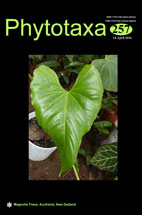Abstract
Cycas hongheensis was firstly proposed as a distinct taxon in 1994 and formally described two years later based on vegetative materials only. Here, the reproductive organs of this species, namely, the female cone, male cone and seeds are supplemented for description as these fertile materials were found for the first time at the type locality. Furthermore, the phylogenetic position of this species as being the only endemic member of Cycas sect. Indosinenses in China was investigated. The conflicting phylogenic results between chloroplastic (cpDNA) and nuclear DNA (nDNA) are corresponded with the inconformity characters of morphology of this species. The characters of lacking indumentum on ovules and the distinct apical spine of megasporophyll are corresponding to nDNA result while the characters such as the soft and rudimentary apical spine of the microsporophyll and the absence of fibrous layer inside the sarcotesta comform to cpDNA result. For the taxonomy, we agree this species to be classified into Cycas sect. Indosinenses for the obvious morphological characters of megasporophyll and ovule as well as deeper evidence from phylogeny based on nuclear data, as biparental inherited nuclear genes could offer more comprehensive genetic information than maternal inherited cpDNA.

